Problem-Solving Techniques in Business Administration Report
VerifiedAdded on 2020/11/12
|10
|5155
|402
Report
AI Summary
This report provides a detailed analysis of business problem-solving techniques and continuous improvement strategies within a business administration context, using Marks & Spencer (M&S) as a case study. It explores various problem-solving methodologies such as PEST analysis, risk analysis, brainstorming, and root cause analysis, along with organizational and legal constraints. The report examines the roles of stakeholders like customers, employees, and investors in the problem-solving process and outlines the steps in business decision-making. Furthermore, it delves into the purpose and benefits of continuous improvement, analyzing techniques like Total Quality Management (TQM) and Lean manufacturing. The report also evaluates the scope and scale of problems, emphasizing the importance of feedback and practical implementation strategies. Finally, the report discusses the implications of adopting recommendations and implementing decisions, providing a comprehensive overview of business administration problem-solving.
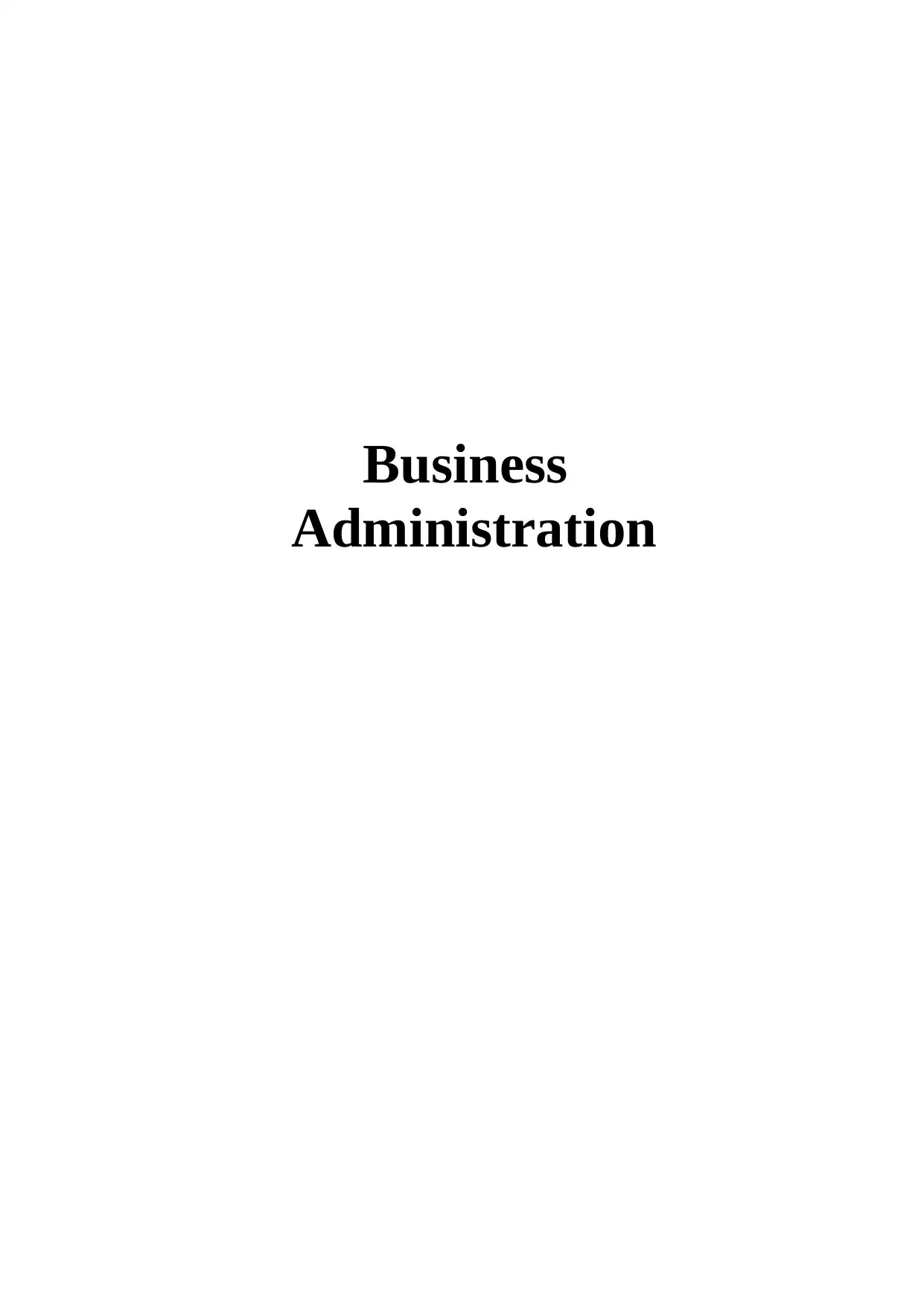
Business
Administration
Administration
Paraphrase This Document
Need a fresh take? Get an instant paraphrase of this document with our AI Paraphraser
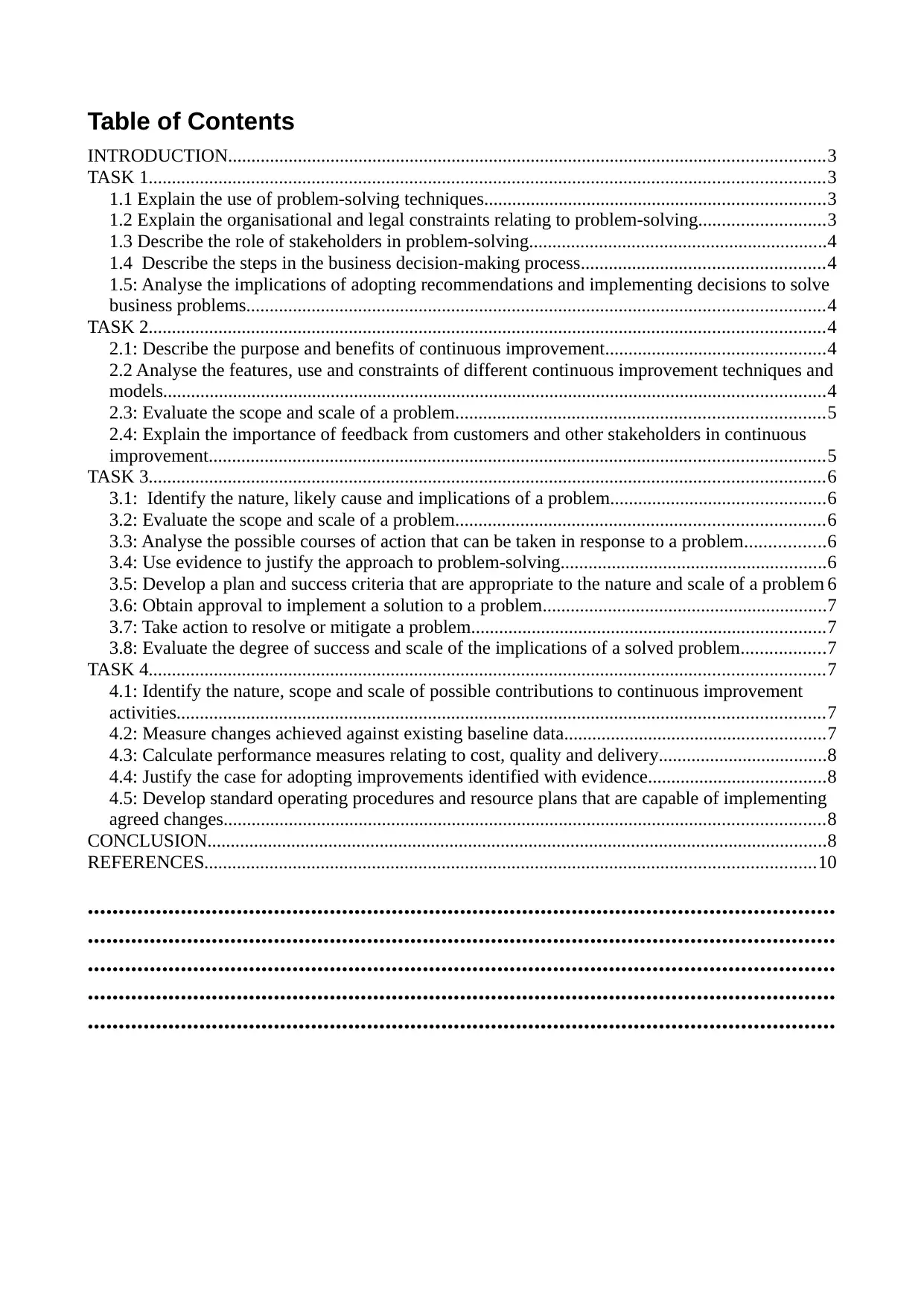
Table of Contents
INTRODUCTION................................................................................................................................3
TASK 1.................................................................................................................................................3
1.1 Explain the use of problem-solving techniques.........................................................................3
1.2 Explain the organisational and legal constraints relating to problem-solving...........................3
1.3 Describe the role of stakeholders in problem-solving................................................................4
1.4 Describe the steps in the business decision-making process....................................................4
1.5: Analyse the implications of adopting recommendations and implementing decisions to solve
business problems............................................................................................................................4
TASK 2.................................................................................................................................................4
2.1: Describe the purpose and benefits of continuous improvement...............................................4
2.2 Analyse the features, use and constraints of different continuous improvement techniques and
models..............................................................................................................................................4
2.3: Evaluate the scope and scale of a problem...............................................................................5
2.4: Explain the importance of feedback from customers and other stakeholders in continuous
improvement....................................................................................................................................5
TASK 3.................................................................................................................................................6
3.1: Identify the nature, likely cause and implications of a problem..............................................6
3.2: Evaluate the scope and scale of a problem...............................................................................6
3.3: Analyse the possible courses of action that can be taken in response to a problem.................6
3.4: Use evidence to justify the approach to problem-solving.........................................................6
3.5: Develop a plan and success criteria that are appropriate to the nature and scale of a problem 6
3.6: Obtain approval to implement a solution to a problem.............................................................7
3.7: Take action to resolve or mitigate a problem............................................................................7
3.8: Evaluate the degree of success and scale of the implications of a solved problem..................7
TASK 4.................................................................................................................................................7
4.1: Identify the nature, scope and scale of possible contributions to continuous improvement
activities...........................................................................................................................................7
4.2: Measure changes achieved against existing baseline data........................................................7
4.3: Calculate performance measures relating to cost, quality and delivery....................................8
4.4: Justify the case for adopting improvements identified with evidence......................................8
4.5: Develop standard operating procedures and resource plans that are capable of implementing
agreed changes.................................................................................................................................8
CONCLUSION.....................................................................................................................................8
REFERENCES...................................................................................................................................10
........................................................................................................................
........................................................................................................................
........................................................................................................................
........................................................................................................................
........................................................................................................................
INTRODUCTION................................................................................................................................3
TASK 1.................................................................................................................................................3
1.1 Explain the use of problem-solving techniques.........................................................................3
1.2 Explain the organisational and legal constraints relating to problem-solving...........................3
1.3 Describe the role of stakeholders in problem-solving................................................................4
1.4 Describe the steps in the business decision-making process....................................................4
1.5: Analyse the implications of adopting recommendations and implementing decisions to solve
business problems............................................................................................................................4
TASK 2.................................................................................................................................................4
2.1: Describe the purpose and benefits of continuous improvement...............................................4
2.2 Analyse the features, use and constraints of different continuous improvement techniques and
models..............................................................................................................................................4
2.3: Evaluate the scope and scale of a problem...............................................................................5
2.4: Explain the importance of feedback from customers and other stakeholders in continuous
improvement....................................................................................................................................5
TASK 3.................................................................................................................................................6
3.1: Identify the nature, likely cause and implications of a problem..............................................6
3.2: Evaluate the scope and scale of a problem...............................................................................6
3.3: Analyse the possible courses of action that can be taken in response to a problem.................6
3.4: Use evidence to justify the approach to problem-solving.........................................................6
3.5: Develop a plan and success criteria that are appropriate to the nature and scale of a problem 6
3.6: Obtain approval to implement a solution to a problem.............................................................7
3.7: Take action to resolve or mitigate a problem............................................................................7
3.8: Evaluate the degree of success and scale of the implications of a solved problem..................7
TASK 4.................................................................................................................................................7
4.1: Identify the nature, scope and scale of possible contributions to continuous improvement
activities...........................................................................................................................................7
4.2: Measure changes achieved against existing baseline data........................................................7
4.3: Calculate performance measures relating to cost, quality and delivery....................................8
4.4: Justify the case for adopting improvements identified with evidence......................................8
4.5: Develop standard operating procedures and resource plans that are capable of implementing
agreed changes.................................................................................................................................8
CONCLUSION.....................................................................................................................................8
REFERENCES...................................................................................................................................10
........................................................................................................................
........................................................................................................................
........................................................................................................................
........................................................................................................................
........................................................................................................................
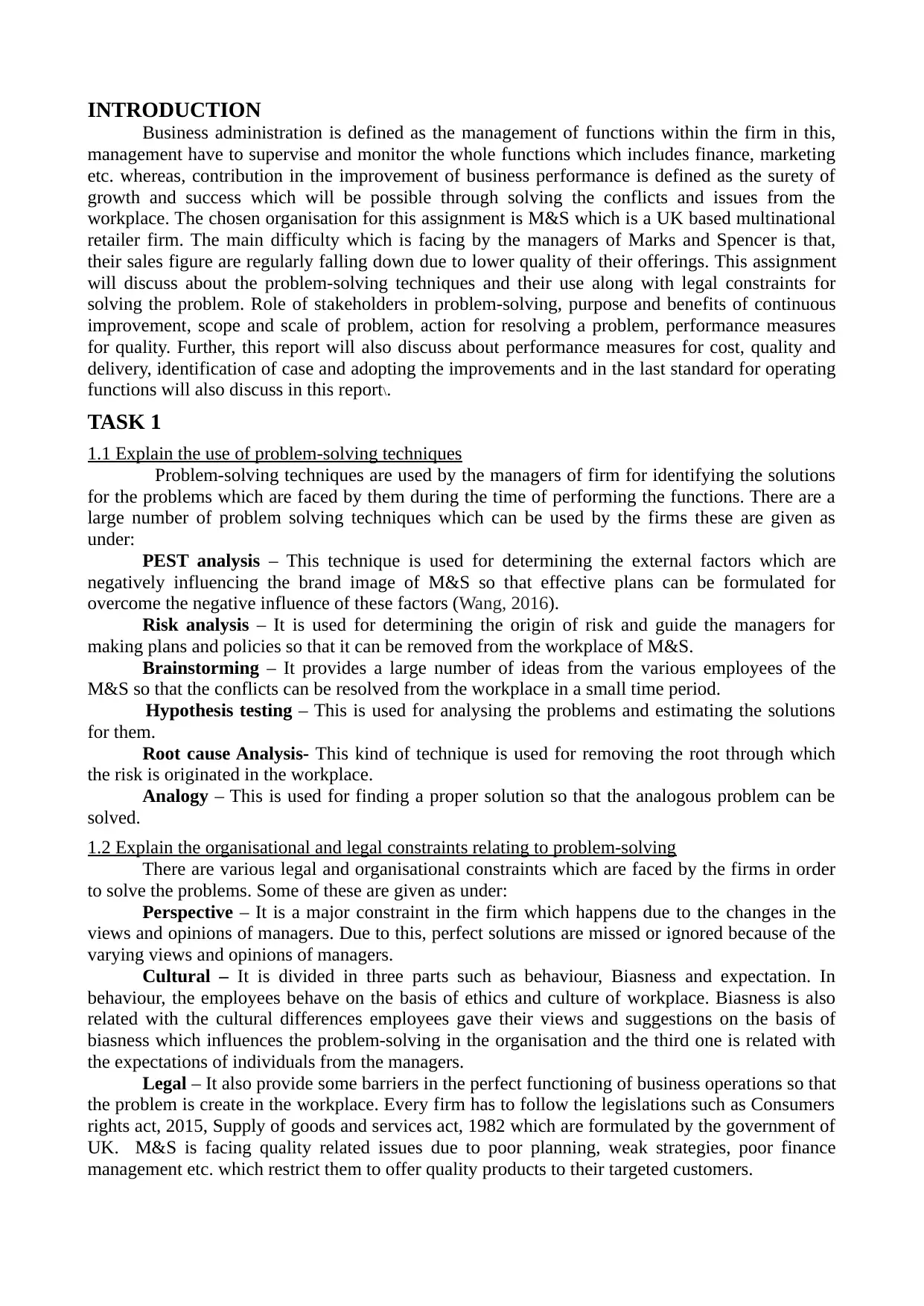
INTRODUCTION
Business administration is defined as the management of functions within the firm in this,
management have to supervise and monitor the whole functions which includes finance, marketing
etc. whereas, contribution in the improvement of business performance is defined as the surety of
growth and success which will be possible through solving the conflicts and issues from the
workplace. The chosen organisation for this assignment is M&S which is a UK based multinational
retailer firm. The main difficulty which is facing by the managers of Marks and Spencer is that,
their sales figure are regularly falling down due to lower quality of their offerings. This assignment
will discuss about the problem-solving techniques and their use along with legal constraints for
solving the problem. Role of stakeholders in problem-solving, purpose and benefits of continuous
improvement, scope and scale of problem, action for resolving a problem, performance measures
for quality. Further, this report will also discuss about performance measures for cost, quality and
delivery, identification of case and adopting the improvements and in the last standard for operating
functions will also discuss in this report\.
TASK 1
1.1 Explain the use of problem-solving techniques
Problem-solving techniques are used by the managers of firm for identifying the solutions
for the problems which are faced by them during the time of performing the functions. There are a
large number of problem solving techniques which can be used by the firms these are given as
under:
PEST analysis – This technique is used for determining the external factors which are
negatively influencing the brand image of M&S so that effective plans can be formulated for
overcome the negative influence of these factors (Wang, 2016).
Risk analysis – It is used for determining the origin of risk and guide the managers for
making plans and policies so that it can be removed from the workplace of M&S.
Brainstorming – It provides a large number of ideas from the various employees of the
M&S so that the conflicts can be resolved from the workplace in a small time period.
Hypothesis testing – This is used for analysing the problems and estimating the solutions
for them.
Root cause Analysis- This kind of technique is used for removing the root through which
the risk is originated in the workplace.
Analogy – This is used for finding a proper solution so that the analogous problem can be
solved.
1.2 Explain the organisational and legal constraints relating to problem-solving
There are various legal and organisational constraints which are faced by the firms in order
to solve the problems. Some of these are given as under:
Perspective – It is a major constraint in the firm which happens due to the changes in the
views and opinions of managers. Due to this, perfect solutions are missed or ignored because of the
varying views and opinions of managers.
Cultural – It is divided in three parts such as behaviour, Biasness and expectation. In
behaviour, the employees behave on the basis of ethics and culture of workplace. Biasness is also
related with the cultural differences employees gave their views and suggestions on the basis of
biasness which influences the problem-solving in the organisation and the third one is related with
the expectations of individuals from the managers.
Legal – It also provide some barriers in the perfect functioning of business operations so that
the problem is create in the workplace. Every firm has to follow the legislations such as Consumers
rights act, 2015, Supply of goods and services act, 1982 which are formulated by the government of
UK. M&S is facing quality related issues due to poor planning, weak strategies, poor finance
management etc. which restrict them to offer quality products to their targeted customers.
Business administration is defined as the management of functions within the firm in this,
management have to supervise and monitor the whole functions which includes finance, marketing
etc. whereas, contribution in the improvement of business performance is defined as the surety of
growth and success which will be possible through solving the conflicts and issues from the
workplace. The chosen organisation for this assignment is M&S which is a UK based multinational
retailer firm. The main difficulty which is facing by the managers of Marks and Spencer is that,
their sales figure are regularly falling down due to lower quality of their offerings. This assignment
will discuss about the problem-solving techniques and their use along with legal constraints for
solving the problem. Role of stakeholders in problem-solving, purpose and benefits of continuous
improvement, scope and scale of problem, action for resolving a problem, performance measures
for quality. Further, this report will also discuss about performance measures for cost, quality and
delivery, identification of case and adopting the improvements and in the last standard for operating
functions will also discuss in this report\.
TASK 1
1.1 Explain the use of problem-solving techniques
Problem-solving techniques are used by the managers of firm for identifying the solutions
for the problems which are faced by them during the time of performing the functions. There are a
large number of problem solving techniques which can be used by the firms these are given as
under:
PEST analysis – This technique is used for determining the external factors which are
negatively influencing the brand image of M&S so that effective plans can be formulated for
overcome the negative influence of these factors (Wang, 2016).
Risk analysis – It is used for determining the origin of risk and guide the managers for
making plans and policies so that it can be removed from the workplace of M&S.
Brainstorming – It provides a large number of ideas from the various employees of the
M&S so that the conflicts can be resolved from the workplace in a small time period.
Hypothesis testing – This is used for analysing the problems and estimating the solutions
for them.
Root cause Analysis- This kind of technique is used for removing the root through which
the risk is originated in the workplace.
Analogy – This is used for finding a proper solution so that the analogous problem can be
solved.
1.2 Explain the organisational and legal constraints relating to problem-solving
There are various legal and organisational constraints which are faced by the firms in order
to solve the problems. Some of these are given as under:
Perspective – It is a major constraint in the firm which happens due to the changes in the
views and opinions of managers. Due to this, perfect solutions are missed or ignored because of the
varying views and opinions of managers.
Cultural – It is divided in three parts such as behaviour, Biasness and expectation. In
behaviour, the employees behave on the basis of ethics and culture of workplace. Biasness is also
related with the cultural differences employees gave their views and suggestions on the basis of
biasness which influences the problem-solving in the organisation and the third one is related with
the expectations of individuals from the managers.
Legal – It also provide some barriers in the perfect functioning of business operations so that
the problem is create in the workplace. Every firm has to follow the legislations such as Consumers
rights act, 2015, Supply of goods and services act, 1982 which are formulated by the government of
UK. M&S is facing quality related issues due to poor planning, weak strategies, poor finance
management etc. which restrict them to offer quality products to their targeted customers.
⊘ This is a preview!⊘
Do you want full access?
Subscribe today to unlock all pages.

Trusted by 1+ million students worldwide
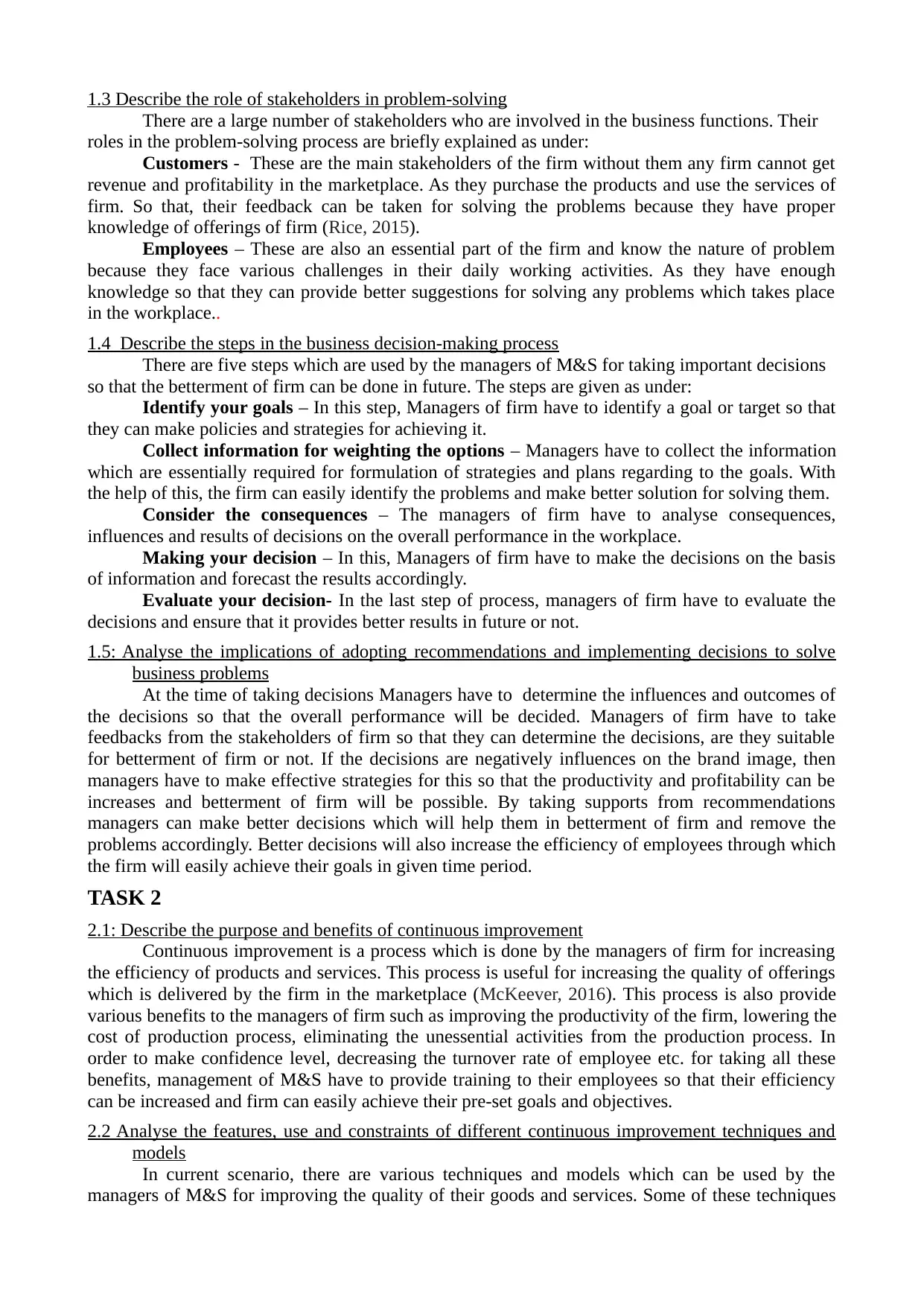
1.3 Describe the role of stakeholders in problem-solving
There are a large number of stakeholders who are involved in the business functions. Their
roles in the problem-solving process are briefly explained as under:
Customers - These are the main stakeholders of the firm without them any firm cannot get
revenue and profitability in the marketplace. As they purchase the products and use the services of
firm. So that, their feedback can be taken for solving the problems because they have proper
knowledge of offerings of firm (Rice, 2015).
Employees – These are also an essential part of the firm and know the nature of problem
because they face various challenges in their daily working activities. As they have enough
knowledge so that they can provide better suggestions for solving any problems which takes place
in the workplace..
1.4 Describe the steps in the business decision-making process
There are five steps which are used by the managers of M&S for taking important decisions
so that the betterment of firm can be done in future. The steps are given as under:
Identify your goals – In this step, Managers of firm have to identify a goal or target so that
they can make policies and strategies for achieving it.
Collect information for weighting the options – Managers have to collect the information
which are essentially required for formulation of strategies and plans regarding to the goals. With
the help of this, the firm can easily identify the problems and make better solution for solving them.
Consider the consequences – The managers of firm have to analyse consequences,
influences and results of decisions on the overall performance in the workplace.
Making your decision – In this, Managers of firm have to make the decisions on the basis
of information and forecast the results accordingly.
Evaluate your decision- In the last step of process, managers of firm have to evaluate the
decisions and ensure that it provides better results in future or not.
1.5: Analyse the implications of adopting recommendations and implementing decisions to solve
business problems
At the time of taking decisions Managers have to determine the influences and outcomes of
the decisions so that the overall performance will be decided. Managers of firm have to take
feedbacks from the stakeholders of firm so that they can determine the decisions, are they suitable
for betterment of firm or not. If the decisions are negatively influences on the brand image, then
managers have to make effective strategies for this so that the productivity and profitability can be
increases and betterment of firm will be possible. By taking supports from recommendations
managers can make better decisions which will help them in betterment of firm and remove the
problems accordingly. Better decisions will also increase the efficiency of employees through which
the firm will easily achieve their goals in given time period.
TASK 2
2.1: Describe the purpose and benefits of continuous improvement
Continuous improvement is a process which is done by the managers of firm for increasing
the efficiency of products and services. This process is useful for increasing the quality of offerings
which is delivered by the firm in the marketplace (McKeever, 2016). This process is also provide
various benefits to the managers of firm such as improving the productivity of the firm, lowering the
cost of production process, eliminating the unessential activities from the production process. In
order to make confidence level, decreasing the turnover rate of employee etc. for taking all these
benefits, management of M&S have to provide training to their employees so that their efficiency
can be increased and firm can easily achieve their pre-set goals and objectives.
2.2 Analyse the features, use and constraints of different continuous improvement techniques and
models
In current scenario, there are various techniques and models which can be used by the
managers of M&S for improving the quality of their goods and services. Some of these techniques
There are a large number of stakeholders who are involved in the business functions. Their
roles in the problem-solving process are briefly explained as under:
Customers - These are the main stakeholders of the firm without them any firm cannot get
revenue and profitability in the marketplace. As they purchase the products and use the services of
firm. So that, their feedback can be taken for solving the problems because they have proper
knowledge of offerings of firm (Rice, 2015).
Employees – These are also an essential part of the firm and know the nature of problem
because they face various challenges in their daily working activities. As they have enough
knowledge so that they can provide better suggestions for solving any problems which takes place
in the workplace..
1.4 Describe the steps in the business decision-making process
There are five steps which are used by the managers of M&S for taking important decisions
so that the betterment of firm can be done in future. The steps are given as under:
Identify your goals – In this step, Managers of firm have to identify a goal or target so that
they can make policies and strategies for achieving it.
Collect information for weighting the options – Managers have to collect the information
which are essentially required for formulation of strategies and plans regarding to the goals. With
the help of this, the firm can easily identify the problems and make better solution for solving them.
Consider the consequences – The managers of firm have to analyse consequences,
influences and results of decisions on the overall performance in the workplace.
Making your decision – In this, Managers of firm have to make the decisions on the basis
of information and forecast the results accordingly.
Evaluate your decision- In the last step of process, managers of firm have to evaluate the
decisions and ensure that it provides better results in future or not.
1.5: Analyse the implications of adopting recommendations and implementing decisions to solve
business problems
At the time of taking decisions Managers have to determine the influences and outcomes of
the decisions so that the overall performance will be decided. Managers of firm have to take
feedbacks from the stakeholders of firm so that they can determine the decisions, are they suitable
for betterment of firm or not. If the decisions are negatively influences on the brand image, then
managers have to make effective strategies for this so that the productivity and profitability can be
increases and betterment of firm will be possible. By taking supports from recommendations
managers can make better decisions which will help them in betterment of firm and remove the
problems accordingly. Better decisions will also increase the efficiency of employees through which
the firm will easily achieve their goals in given time period.
TASK 2
2.1: Describe the purpose and benefits of continuous improvement
Continuous improvement is a process which is done by the managers of firm for increasing
the efficiency of products and services. This process is useful for increasing the quality of offerings
which is delivered by the firm in the marketplace (McKeever, 2016). This process is also provide
various benefits to the managers of firm such as improving the productivity of the firm, lowering the
cost of production process, eliminating the unessential activities from the production process. In
order to make confidence level, decreasing the turnover rate of employee etc. for taking all these
benefits, management of M&S have to provide training to their employees so that their efficiency
can be increased and firm can easily achieve their pre-set goals and objectives.
2.2 Analyse the features, use and constraints of different continuous improvement techniques and
models
In current scenario, there are various techniques and models which can be used by the
managers of M&S for improving the quality of their goods and services. Some of these techniques
Paraphrase This Document
Need a fresh take? Get an instant paraphrase of this document with our AI Paraphraser
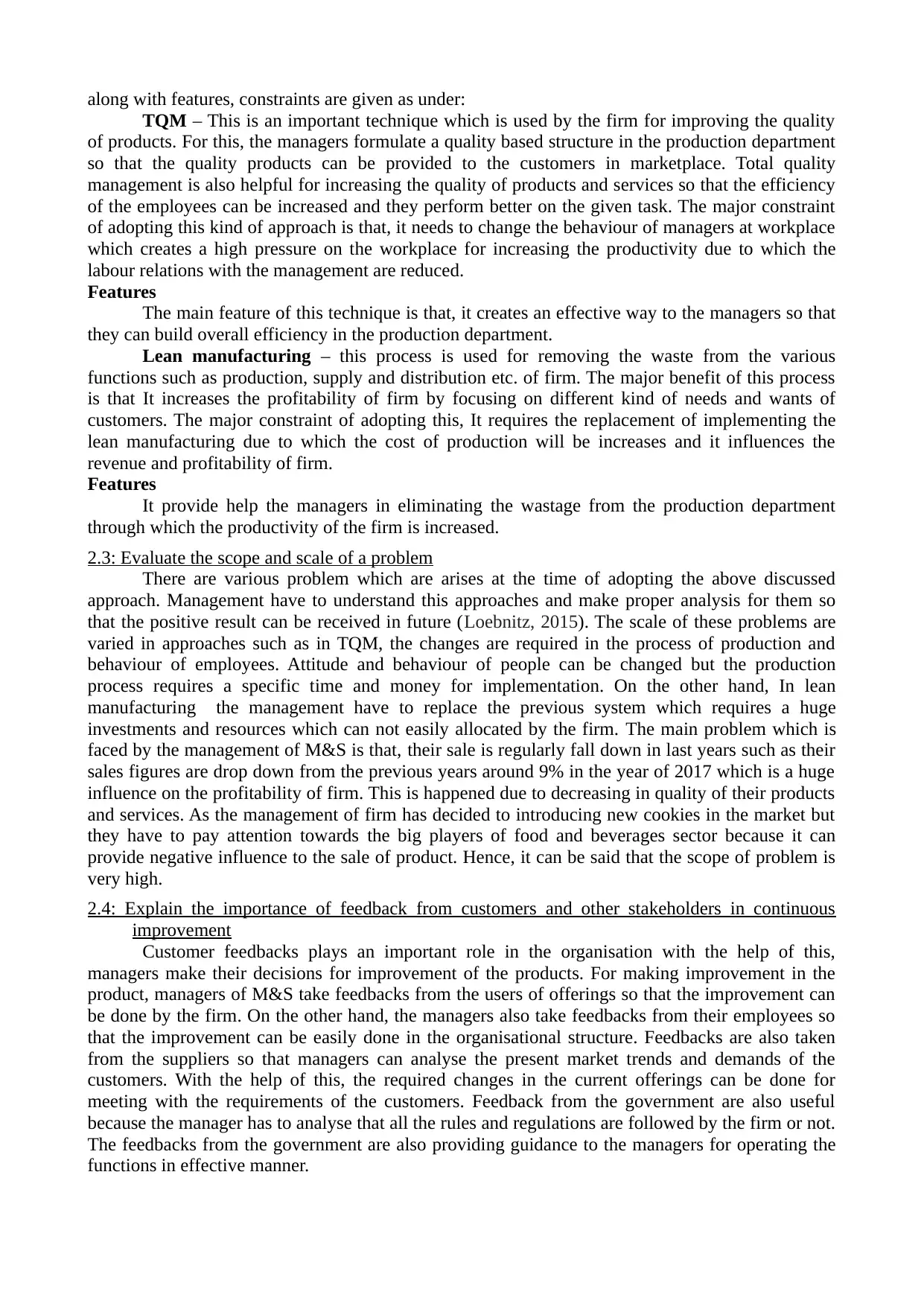
along with features, constraints are given as under:
TQM – This is an important technique which is used by the firm for improving the quality
of products. For this, the managers formulate a quality based structure in the production department
so that the quality products can be provided to the customers in marketplace. Total quality
management is also helpful for increasing the quality of products and services so that the efficiency
of the employees can be increased and they perform better on the given task. The major constraint
of adopting this kind of approach is that, it needs to change the behaviour of managers at workplace
which creates a high pressure on the workplace for increasing the productivity due to which the
labour relations with the management are reduced.
Features
The main feature of this technique is that, it creates an effective way to the managers so that
they can build overall efficiency in the production department.
Lean manufacturing – this process is used for removing the waste from the various
functions such as production, supply and distribution etc. of firm. The major benefit of this process
is that It increases the profitability of firm by focusing on different kind of needs and wants of
customers. The major constraint of adopting this, It requires the replacement of implementing the
lean manufacturing due to which the cost of production will be increases and it influences the
revenue and profitability of firm.
Features
It provide help the managers in eliminating the wastage from the production department
through which the productivity of the firm is increased.
2.3: Evaluate the scope and scale of a problem
There are various problem which are arises at the time of adopting the above discussed
approach. Management have to understand this approaches and make proper analysis for them so
that the positive result can be received in future (Loebnitz, 2015). The scale of these problems are
varied in approaches such as in TQM, the changes are required in the process of production and
behaviour of employees. Attitude and behaviour of people can be changed but the production
process requires a specific time and money for implementation. On the other hand, In lean
manufacturing the management have to replace the previous system which requires a huge
investments and resources which can not easily allocated by the firm. The main problem which is
faced by the management of M&S is that, their sale is regularly fall down in last years such as their
sales figures are drop down from the previous years around 9% in the year of 2017 which is a huge
influence on the profitability of firm. This is happened due to decreasing in quality of their products
and services. As the management of firm has decided to introducing new cookies in the market but
they have to pay attention towards the big players of food and beverages sector because it can
provide negative influence to the sale of product. Hence, it can be said that the scope of problem is
very high.
2.4: Explain the importance of feedback from customers and other stakeholders in continuous
improvement
Customer feedbacks plays an important role in the organisation with the help of this,
managers make their decisions for improvement of the products. For making improvement in the
product, managers of M&S take feedbacks from the users of offerings so that the improvement can
be done by the firm. On the other hand, the managers also take feedbacks from their employees so
that the improvement can be easily done in the organisational structure. Feedbacks are also taken
from the suppliers so that managers can analyse the present market trends and demands of the
customers. With the help of this, the required changes in the current offerings can be done for
meeting with the requirements of the customers. Feedback from the government are also useful
because the manager has to analyse that all the rules and regulations are followed by the firm or not.
The feedbacks from the government are also providing guidance to the managers for operating the
functions in effective manner.
TQM – This is an important technique which is used by the firm for improving the quality
of products. For this, the managers formulate a quality based structure in the production department
so that the quality products can be provided to the customers in marketplace. Total quality
management is also helpful for increasing the quality of products and services so that the efficiency
of the employees can be increased and they perform better on the given task. The major constraint
of adopting this kind of approach is that, it needs to change the behaviour of managers at workplace
which creates a high pressure on the workplace for increasing the productivity due to which the
labour relations with the management are reduced.
Features
The main feature of this technique is that, it creates an effective way to the managers so that
they can build overall efficiency in the production department.
Lean manufacturing – this process is used for removing the waste from the various
functions such as production, supply and distribution etc. of firm. The major benefit of this process
is that It increases the profitability of firm by focusing on different kind of needs and wants of
customers. The major constraint of adopting this, It requires the replacement of implementing the
lean manufacturing due to which the cost of production will be increases and it influences the
revenue and profitability of firm.
Features
It provide help the managers in eliminating the wastage from the production department
through which the productivity of the firm is increased.
2.3: Evaluate the scope and scale of a problem
There are various problem which are arises at the time of adopting the above discussed
approach. Management have to understand this approaches and make proper analysis for them so
that the positive result can be received in future (Loebnitz, 2015). The scale of these problems are
varied in approaches such as in TQM, the changes are required in the process of production and
behaviour of employees. Attitude and behaviour of people can be changed but the production
process requires a specific time and money for implementation. On the other hand, In lean
manufacturing the management have to replace the previous system which requires a huge
investments and resources which can not easily allocated by the firm. The main problem which is
faced by the management of M&S is that, their sale is regularly fall down in last years such as their
sales figures are drop down from the previous years around 9% in the year of 2017 which is a huge
influence on the profitability of firm. This is happened due to decreasing in quality of their products
and services. As the management of firm has decided to introducing new cookies in the market but
they have to pay attention towards the big players of food and beverages sector because it can
provide negative influence to the sale of product. Hence, it can be said that the scope of problem is
very high.
2.4: Explain the importance of feedback from customers and other stakeholders in continuous
improvement
Customer feedbacks plays an important role in the organisation with the help of this,
managers make their decisions for improvement of the products. For making improvement in the
product, managers of M&S take feedbacks from the users of offerings so that the improvement can
be done by the firm. On the other hand, the managers also take feedbacks from their employees so
that the improvement can be easily done in the organisational structure. Feedbacks are also taken
from the suppliers so that managers can analyse the present market trends and demands of the
customers. With the help of this, the required changes in the current offerings can be done for
meeting with the requirements of the customers. Feedback from the government are also useful
because the manager has to analyse that all the rules and regulations are followed by the firm or not.
The feedbacks from the government are also providing guidance to the managers for operating the
functions in effective manner.
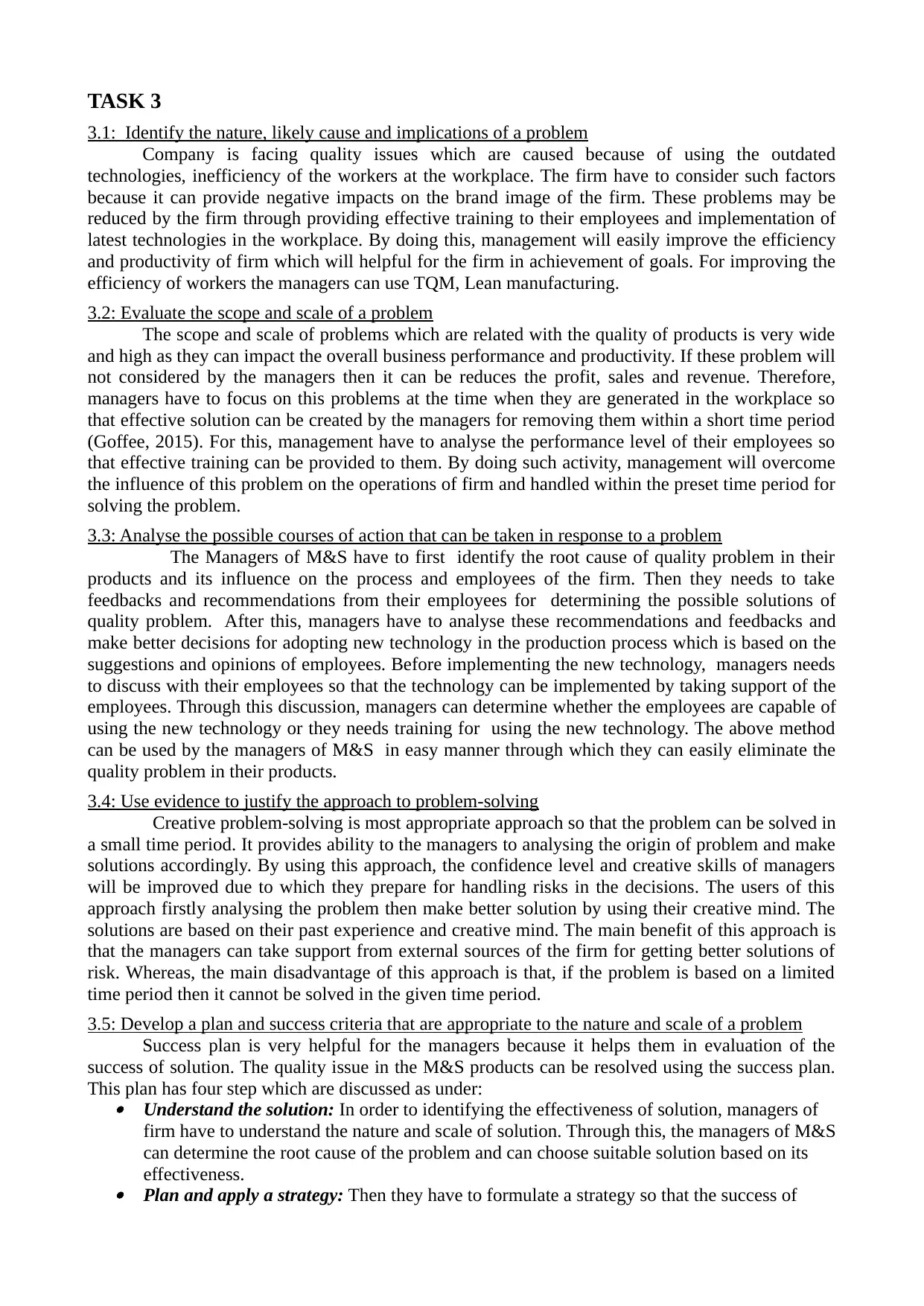
TASK 3
3.1: Identify the nature, likely cause and implications of a problem
Company is facing quality issues which are caused because of using the outdated
technologies, inefficiency of the workers at the workplace. The firm have to consider such factors
because it can provide negative impacts on the brand image of the firm. These problems may be
reduced by the firm through providing effective training to their employees and implementation of
latest technologies in the workplace. By doing this, management will easily improve the efficiency
and productivity of firm which will helpful for the firm in achievement of goals. For improving the
efficiency of workers the managers can use TQM, Lean manufacturing.
3.2: Evaluate the scope and scale of a problem
The scope and scale of problems which are related with the quality of products is very wide
and high as they can impact the overall business performance and productivity. If these problem will
not considered by the managers then it can be reduces the profit, sales and revenue. Therefore,
managers have to focus on this problems at the time when they are generated in the workplace so
that effective solution can be created by the managers for removing them within a short time period
(Goffee, 2015). For this, management have to analyse the performance level of their employees so
that effective training can be provided to them. By doing such activity, management will overcome
the influence of this problem on the operations of firm and handled within the preset time period for
solving the problem.
3.3: Analyse the possible courses of action that can be taken in response to a problem
The Managers of M&S have to first identify the root cause of quality problem in their
products and its influence on the process and employees of the firm. Then they needs to take
feedbacks and recommendations from their employees for determining the possible solutions of
quality problem. After this, managers have to analyse these recommendations and feedbacks and
make better decisions for adopting new technology in the production process which is based on the
suggestions and opinions of employees. Before implementing the new technology, managers needs
to discuss with their employees so that the technology can be implemented by taking support of the
employees. Through this discussion, managers can determine whether the employees are capable of
using the new technology or they needs training for using the new technology. The above method
can be used by the managers of M&S in easy manner through which they can easily eliminate the
quality problem in their products.
3.4: Use evidence to justify the approach to problem-solving
Creative problem-solving is most appropriate approach so that the problem can be solved in
a small time period. It provides ability to the managers to analysing the origin of problem and make
solutions accordingly. By using this approach, the confidence level and creative skills of managers
will be improved due to which they prepare for handling risks in the decisions. The users of this
approach firstly analysing the problem then make better solution by using their creative mind. The
solutions are based on their past experience and creative mind. The main benefit of this approach is
that the managers can take support from external sources of the firm for getting better solutions of
risk. Whereas, the main disadvantage of this approach is that, if the problem is based on a limited
time period then it cannot be solved in the given time period.
3.5: Develop a plan and success criteria that are appropriate to the nature and scale of a problem
Success plan is very helpful for the managers because it helps them in evaluation of the
success of solution. The quality issue in the M&S products can be resolved using the success plan.
This plan has four step which are discussed as under:
Understand the solution: In order to identifying the effectiveness of solution, managers of
firm have to understand the nature and scale of solution. Through this, the managers of M&S
can determine the root cause of the problem and can choose suitable solution based on its
effectiveness.
Plan and apply a strategy: Then they have to formulate a strategy so that the success of
3.1: Identify the nature, likely cause and implications of a problem
Company is facing quality issues which are caused because of using the outdated
technologies, inefficiency of the workers at the workplace. The firm have to consider such factors
because it can provide negative impacts on the brand image of the firm. These problems may be
reduced by the firm through providing effective training to their employees and implementation of
latest technologies in the workplace. By doing this, management will easily improve the efficiency
and productivity of firm which will helpful for the firm in achievement of goals. For improving the
efficiency of workers the managers can use TQM, Lean manufacturing.
3.2: Evaluate the scope and scale of a problem
The scope and scale of problems which are related with the quality of products is very wide
and high as they can impact the overall business performance and productivity. If these problem will
not considered by the managers then it can be reduces the profit, sales and revenue. Therefore,
managers have to focus on this problems at the time when they are generated in the workplace so
that effective solution can be created by the managers for removing them within a short time period
(Goffee, 2015). For this, management have to analyse the performance level of their employees so
that effective training can be provided to them. By doing such activity, management will overcome
the influence of this problem on the operations of firm and handled within the preset time period for
solving the problem.
3.3: Analyse the possible courses of action that can be taken in response to a problem
The Managers of M&S have to first identify the root cause of quality problem in their
products and its influence on the process and employees of the firm. Then they needs to take
feedbacks and recommendations from their employees for determining the possible solutions of
quality problem. After this, managers have to analyse these recommendations and feedbacks and
make better decisions for adopting new technology in the production process which is based on the
suggestions and opinions of employees. Before implementing the new technology, managers needs
to discuss with their employees so that the technology can be implemented by taking support of the
employees. Through this discussion, managers can determine whether the employees are capable of
using the new technology or they needs training for using the new technology. The above method
can be used by the managers of M&S in easy manner through which they can easily eliminate the
quality problem in their products.
3.4: Use evidence to justify the approach to problem-solving
Creative problem-solving is most appropriate approach so that the problem can be solved in
a small time period. It provides ability to the managers to analysing the origin of problem and make
solutions accordingly. By using this approach, the confidence level and creative skills of managers
will be improved due to which they prepare for handling risks in the decisions. The users of this
approach firstly analysing the problem then make better solution by using their creative mind. The
solutions are based on their past experience and creative mind. The main benefit of this approach is
that the managers can take support from external sources of the firm for getting better solutions of
risk. Whereas, the main disadvantage of this approach is that, if the problem is based on a limited
time period then it cannot be solved in the given time period.
3.5: Develop a plan and success criteria that are appropriate to the nature and scale of a problem
Success plan is very helpful for the managers because it helps them in evaluation of the
success of solution. The quality issue in the M&S products can be resolved using the success plan.
This plan has four step which are discussed as under:
Understand the solution: In order to identifying the effectiveness of solution, managers of
firm have to understand the nature and scale of solution. Through this, the managers of M&S
can determine the root cause of the problem and can choose suitable solution based on its
effectiveness.
Plan and apply a strategy: Then they have to formulate a strategy so that the success of
⊘ This is a preview!⊘
Do you want full access?
Subscribe today to unlock all pages.

Trusted by 1+ million students worldwide
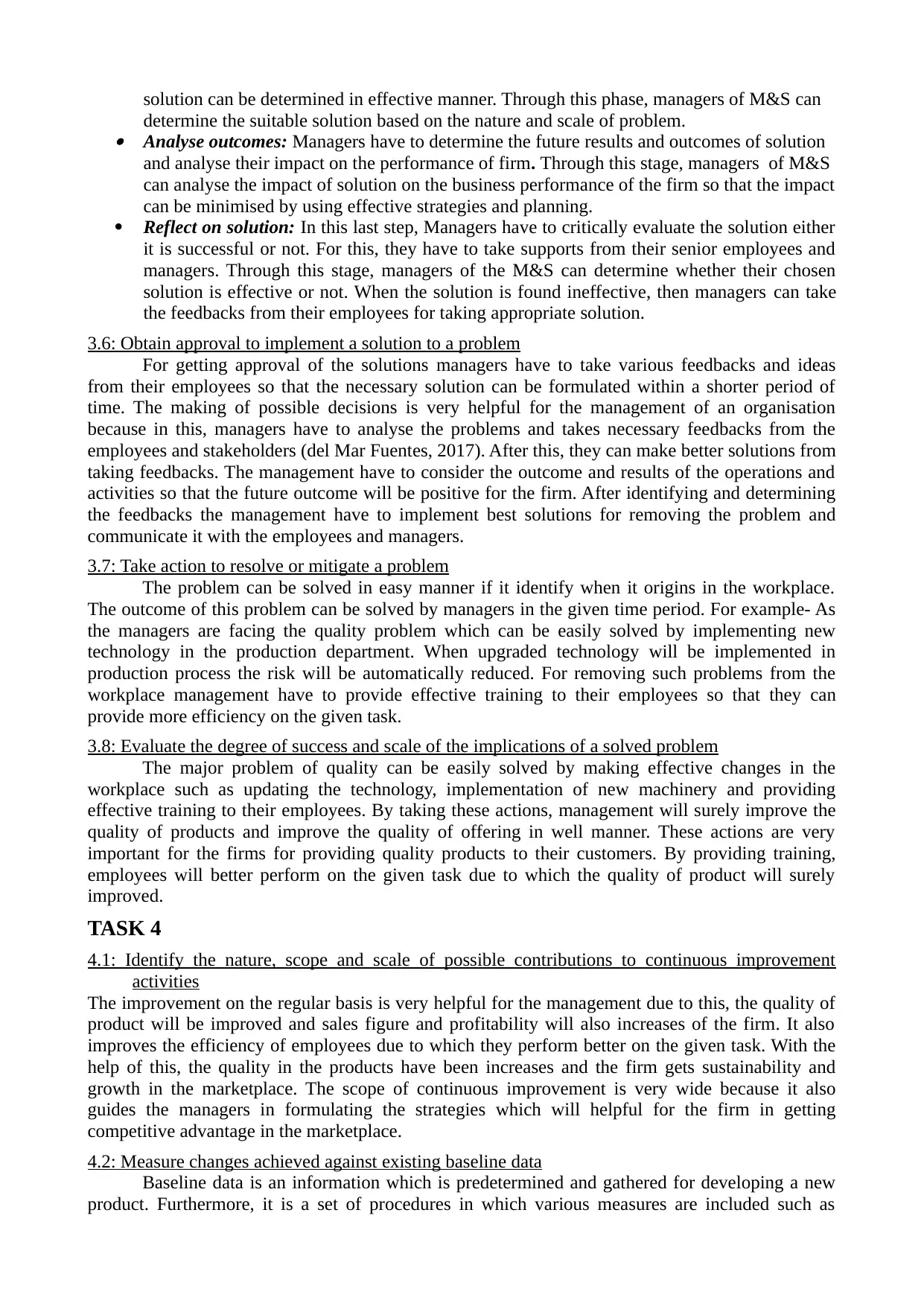
solution can be determined in effective manner. Through this phase, managers of M&S can
determine the suitable solution based on the nature and scale of problem.
Analyse outcomes: Managers have to determine the future results and outcomes of solution
and analyse their impact on the performance of firm. Through this stage, managers of M&S
can analyse the impact of solution on the business performance of the firm so that the impact
can be minimised by using effective strategies and planning.
Reflect on solution: In this last step, Managers have to critically evaluate the solution either
it is successful or not. For this, they have to take supports from their senior employees and
managers. Through this stage, managers of the M&S can determine whether their chosen
solution is effective or not. When the solution is found ineffective, then managers can take
the feedbacks from their employees for taking appropriate solution.
3.6: Obtain approval to implement a solution to a problem
For getting approval of the solutions managers have to take various feedbacks and ideas
from their employees so that the necessary solution can be formulated within a shorter period of
time. The making of possible decisions is very helpful for the management of an organisation
because in this, managers have to analyse the problems and takes necessary feedbacks from the
employees and stakeholders (del Mar Fuentes, 2017). After this, they can make better solutions from
taking feedbacks. The management have to consider the outcome and results of the operations and
activities so that the future outcome will be positive for the firm. After identifying and determining
the feedbacks the management have to implement best solutions for removing the problem and
communicate it with the employees and managers.
3.7: Take action to resolve or mitigate a problem
The problem can be solved in easy manner if it identify when it origins in the workplace.
The outcome of this problem can be solved by managers in the given time period. For example- As
the managers are facing the quality problem which can be easily solved by implementing new
technology in the production department. When upgraded technology will be implemented in
production process the risk will be automatically reduced. For removing such problems from the
workplace management have to provide effective training to their employees so that they can
provide more efficiency on the given task.
3.8: Evaluate the degree of success and scale of the implications of a solved problem
The major problem of quality can be easily solved by making effective changes in the
workplace such as updating the technology, implementation of new machinery and providing
effective training to their employees. By taking these actions, management will surely improve the
quality of products and improve the quality of offering in well manner. These actions are very
important for the firms for providing quality products to their customers. By providing training,
employees will better perform on the given task due to which the quality of product will surely
improved.
TASK 4
4.1: Identify the nature, scope and scale of possible contributions to continuous improvement
activities
The improvement on the regular basis is very helpful for the management due to this, the quality of
product will be improved and sales figure and profitability will also increases of the firm. It also
improves the efficiency of employees due to which they perform better on the given task. With the
help of this, the quality in the products have been increases and the firm gets sustainability and
growth in the marketplace. The scope of continuous improvement is very wide because it also
guides the managers in formulating the strategies which will helpful for the firm in getting
competitive advantage in the marketplace.
4.2: Measure changes achieved against existing baseline data
Baseline data is an information which is predetermined and gathered for developing a new
product. Furthermore, it is a set of procedures in which various measures are included such as
determine the suitable solution based on the nature and scale of problem.
Analyse outcomes: Managers have to determine the future results and outcomes of solution
and analyse their impact on the performance of firm. Through this stage, managers of M&S
can analyse the impact of solution on the business performance of the firm so that the impact
can be minimised by using effective strategies and planning.
Reflect on solution: In this last step, Managers have to critically evaluate the solution either
it is successful or not. For this, they have to take supports from their senior employees and
managers. Through this stage, managers of the M&S can determine whether their chosen
solution is effective or not. When the solution is found ineffective, then managers can take
the feedbacks from their employees for taking appropriate solution.
3.6: Obtain approval to implement a solution to a problem
For getting approval of the solutions managers have to take various feedbacks and ideas
from their employees so that the necessary solution can be formulated within a shorter period of
time. The making of possible decisions is very helpful for the management of an organisation
because in this, managers have to analyse the problems and takes necessary feedbacks from the
employees and stakeholders (del Mar Fuentes, 2017). After this, they can make better solutions from
taking feedbacks. The management have to consider the outcome and results of the operations and
activities so that the future outcome will be positive for the firm. After identifying and determining
the feedbacks the management have to implement best solutions for removing the problem and
communicate it with the employees and managers.
3.7: Take action to resolve or mitigate a problem
The problem can be solved in easy manner if it identify when it origins in the workplace.
The outcome of this problem can be solved by managers in the given time period. For example- As
the managers are facing the quality problem which can be easily solved by implementing new
technology in the production department. When upgraded technology will be implemented in
production process the risk will be automatically reduced. For removing such problems from the
workplace management have to provide effective training to their employees so that they can
provide more efficiency on the given task.
3.8: Evaluate the degree of success and scale of the implications of a solved problem
The major problem of quality can be easily solved by making effective changes in the
workplace such as updating the technology, implementation of new machinery and providing
effective training to their employees. By taking these actions, management will surely improve the
quality of products and improve the quality of offering in well manner. These actions are very
important for the firms for providing quality products to their customers. By providing training,
employees will better perform on the given task due to which the quality of product will surely
improved.
TASK 4
4.1: Identify the nature, scope and scale of possible contributions to continuous improvement
activities
The improvement on the regular basis is very helpful for the management due to this, the quality of
product will be improved and sales figure and profitability will also increases of the firm. It also
improves the efficiency of employees due to which they perform better on the given task. With the
help of this, the quality in the products have been increases and the firm gets sustainability and
growth in the marketplace. The scope of continuous improvement is very wide because it also
guides the managers in formulating the strategies which will helpful for the firm in getting
competitive advantage in the marketplace.
4.2: Measure changes achieved against existing baseline data
Baseline data is an information which is predetermined and gathered for developing a new
product. Furthermore, it is a set of procedures in which various measures are included such as
Paraphrase This Document
Need a fresh take? Get an instant paraphrase of this document with our AI Paraphraser
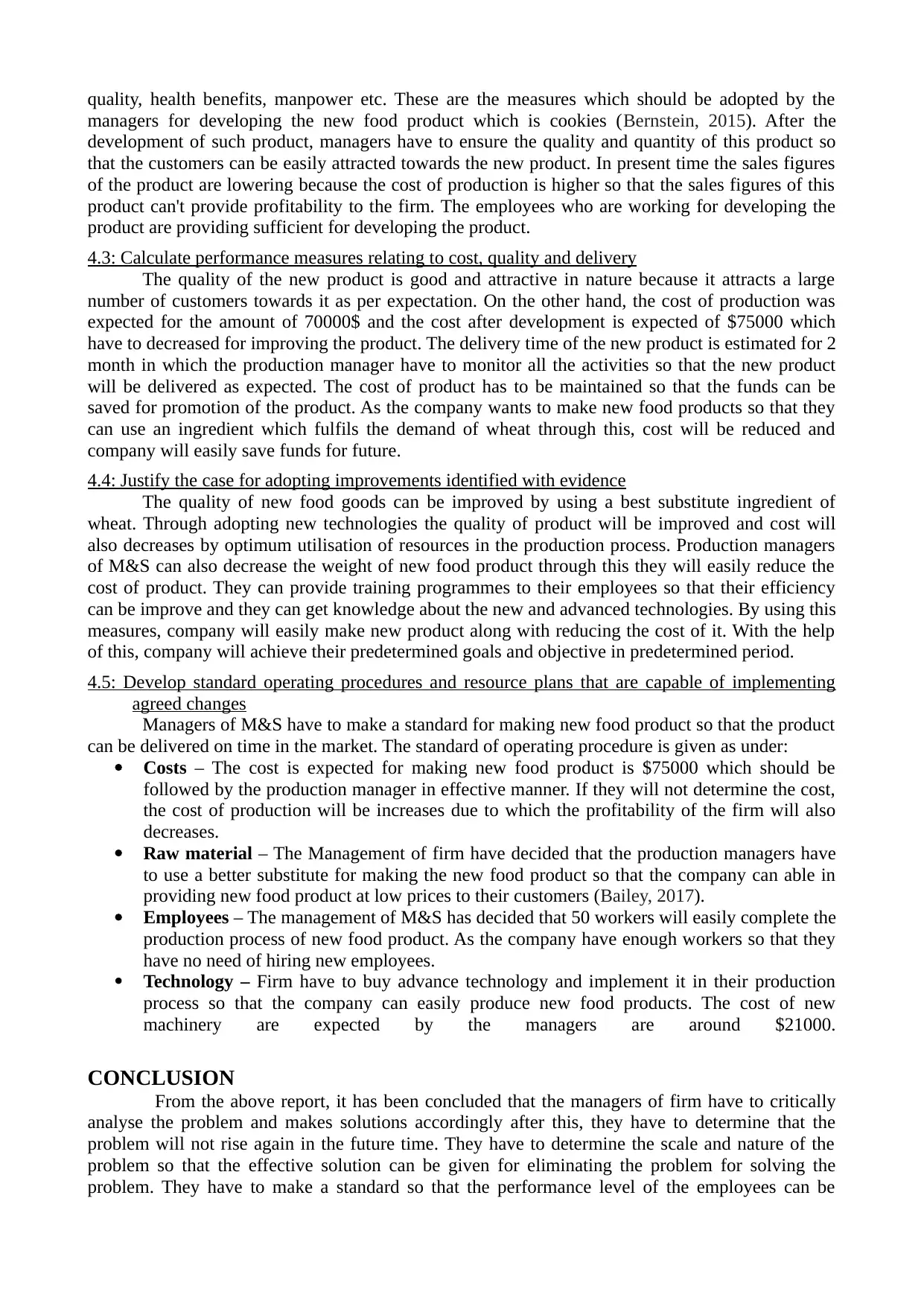
quality, health benefits, manpower etc. These are the measures which should be adopted by the
managers for developing the new food product which is cookies (Bernstein, 2015). After the
development of such product, managers have to ensure the quality and quantity of this product so
that the customers can be easily attracted towards the new product. In present time the sales figures
of the product are lowering because the cost of production is higher so that the sales figures of this
product can't provide profitability to the firm. The employees who are working for developing the
product are providing sufficient for developing the product.
4.3: Calculate performance measures relating to cost, quality and delivery
The quality of the new product is good and attractive in nature because it attracts a large
number of customers towards it as per expectation. On the other hand, the cost of production was
expected for the amount of 70000$ and the cost after development is expected of $75000 which
have to decreased for improving the product. The delivery time of the new product is estimated for 2
month in which the production manager have to monitor all the activities so that the new product
will be delivered as expected. The cost of product has to be maintained so that the funds can be
saved for promotion of the product. As the company wants to make new food products so that they
can use an ingredient which fulfils the demand of wheat through this, cost will be reduced and
company will easily save funds for future.
4.4: Justify the case for adopting improvements identified with evidence
The quality of new food goods can be improved by using a best substitute ingredient of
wheat. Through adopting new technologies the quality of product will be improved and cost will
also decreases by optimum utilisation of resources in the production process. Production managers
of M&S can also decrease the weight of new food product through this they will easily reduce the
cost of product. They can provide training programmes to their employees so that their efficiency
can be improve and they can get knowledge about the new and advanced technologies. By using this
measures, company will easily make new product along with reducing the cost of it. With the help
of this, company will achieve their predetermined goals and objective in predetermined period.
4.5: Develop standard operating procedures and resource plans that are capable of implementing
agreed changes
Managers of M&S have to make a standard for making new food product so that the product
can be delivered on time in the market. The standard of operating procedure is given as under:
Costs – The cost is expected for making new food product is $75000 which should be
followed by the production manager in effective manner. If they will not determine the cost,
the cost of production will be increases due to which the profitability of the firm will also
decreases.
Raw material – The Management of firm have decided that the production managers have
to use a better substitute for making the new food product so that the company can able in
providing new food product at low prices to their customers (Bailey, 2017).
Employees – The management of M&S has decided that 50 workers will easily complete the
production process of new food product. As the company have enough workers so that they
have no need of hiring new employees.
Technology – Firm have to buy advance technology and implement it in their production
process so that the company can easily produce new food products. The cost of new
machinery are expected by the managers are around $21000.
CONCLUSION
From the above report, it has been concluded that the managers of firm have to critically
analyse the problem and makes solutions accordingly after this, they have to determine that the
problem will not rise again in the future time. They have to determine the scale and nature of the
problem so that the effective solution can be given for eliminating the problem for solving the
problem. They have to make a standard so that the performance level of the employees can be
managers for developing the new food product which is cookies (Bernstein, 2015). After the
development of such product, managers have to ensure the quality and quantity of this product so
that the customers can be easily attracted towards the new product. In present time the sales figures
of the product are lowering because the cost of production is higher so that the sales figures of this
product can't provide profitability to the firm. The employees who are working for developing the
product are providing sufficient for developing the product.
4.3: Calculate performance measures relating to cost, quality and delivery
The quality of the new product is good and attractive in nature because it attracts a large
number of customers towards it as per expectation. On the other hand, the cost of production was
expected for the amount of 70000$ and the cost after development is expected of $75000 which
have to decreased for improving the product. The delivery time of the new product is estimated for 2
month in which the production manager have to monitor all the activities so that the new product
will be delivered as expected. The cost of product has to be maintained so that the funds can be
saved for promotion of the product. As the company wants to make new food products so that they
can use an ingredient which fulfils the demand of wheat through this, cost will be reduced and
company will easily save funds for future.
4.4: Justify the case for adopting improvements identified with evidence
The quality of new food goods can be improved by using a best substitute ingredient of
wheat. Through adopting new technologies the quality of product will be improved and cost will
also decreases by optimum utilisation of resources in the production process. Production managers
of M&S can also decrease the weight of new food product through this they will easily reduce the
cost of product. They can provide training programmes to their employees so that their efficiency
can be improve and they can get knowledge about the new and advanced technologies. By using this
measures, company will easily make new product along with reducing the cost of it. With the help
of this, company will achieve their predetermined goals and objective in predetermined period.
4.5: Develop standard operating procedures and resource plans that are capable of implementing
agreed changes
Managers of M&S have to make a standard for making new food product so that the product
can be delivered on time in the market. The standard of operating procedure is given as under:
Costs – The cost is expected for making new food product is $75000 which should be
followed by the production manager in effective manner. If they will not determine the cost,
the cost of production will be increases due to which the profitability of the firm will also
decreases.
Raw material – The Management of firm have decided that the production managers have
to use a better substitute for making the new food product so that the company can able in
providing new food product at low prices to their customers (Bailey, 2017).
Employees – The management of M&S has decided that 50 workers will easily complete the
production process of new food product. As the company have enough workers so that they
have no need of hiring new employees.
Technology – Firm have to buy advance technology and implement it in their production
process so that the company can easily produce new food products. The cost of new
machinery are expected by the managers are around $21000.
CONCLUSION
From the above report, it has been concluded that the managers of firm have to critically
analyse the problem and makes solutions accordingly after this, they have to determine that the
problem will not rise again in the future time. They have to determine the scale and nature of the
problem so that the effective solution can be given for eliminating the problem for solving the
problem. They have to make a standard so that the performance level of the employees can be
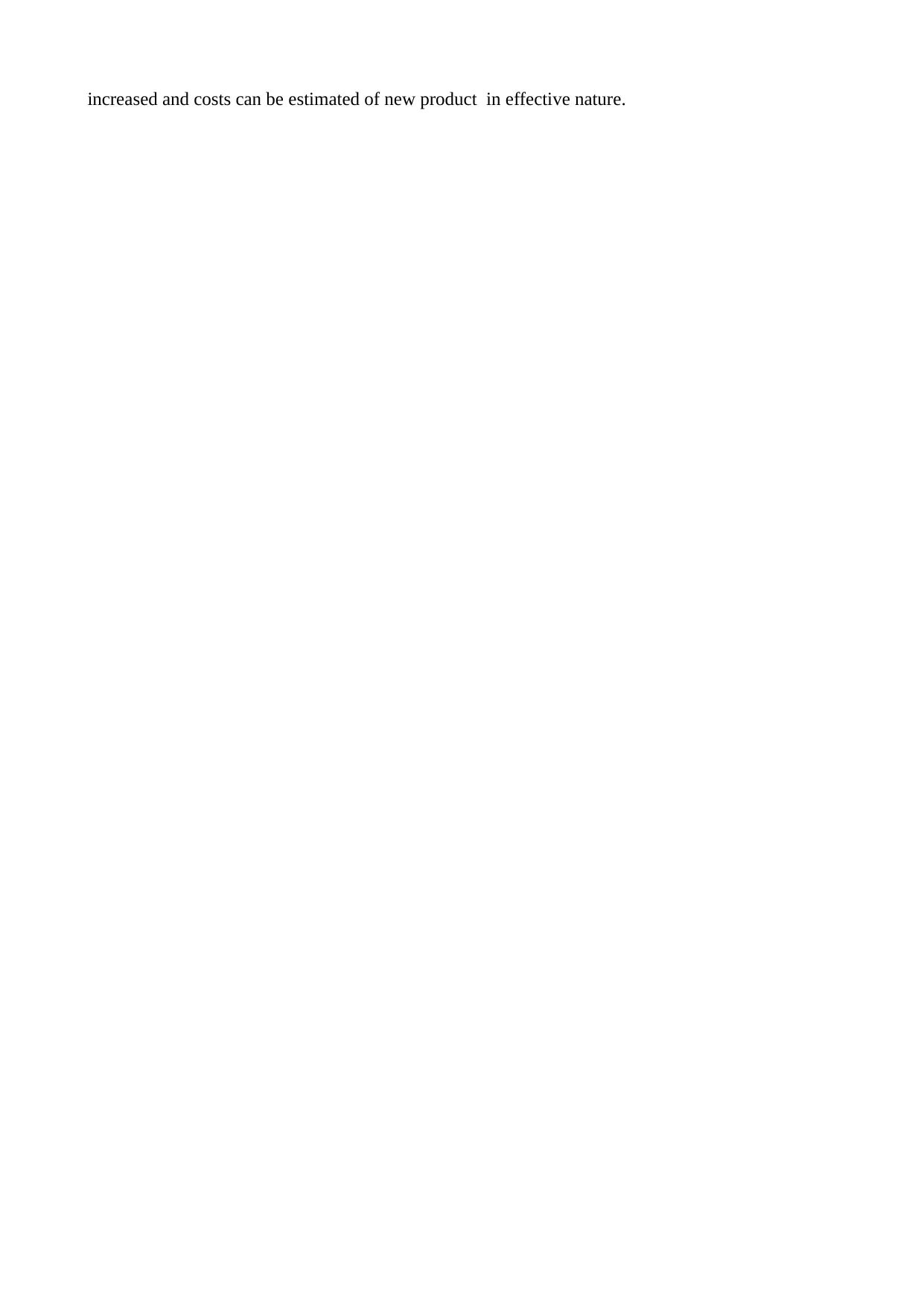
increased and costs can be estimated of new product in effective nature.
⊘ This is a preview!⊘
Do you want full access?
Subscribe today to unlock all pages.

Trusted by 1+ million students worldwide
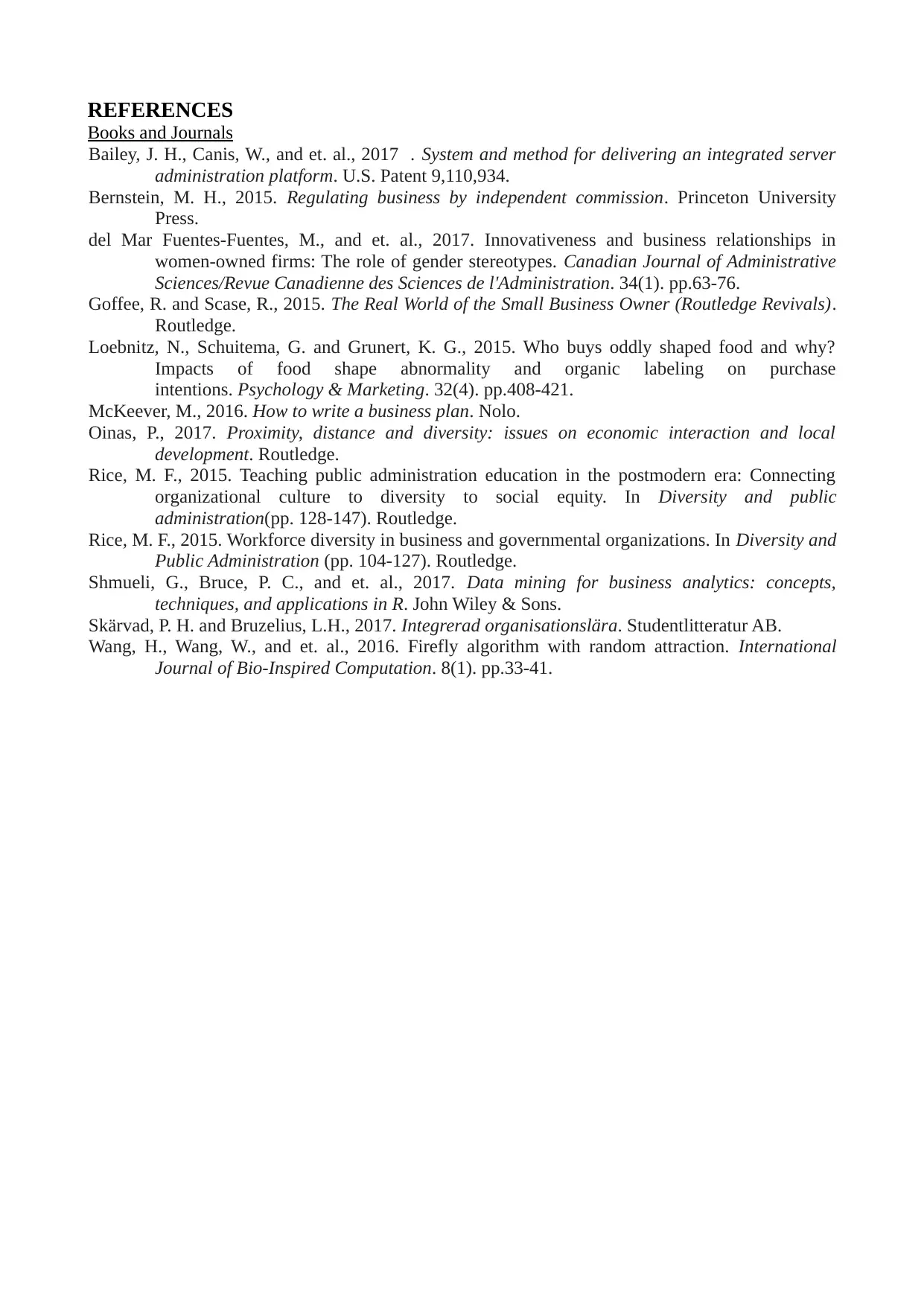
REFERENCES
Books and Journals
Bailey, J. H., Canis, W., and et. al., 2017 . System and method for delivering an integrated server
administration platform. U.S. Patent 9,110,934.
Bernstein, M. H., 2015. Regulating business by independent commission. Princeton University
Press.
del Mar Fuentes‐Fuentes, M., and et. al., 2017. Innovativeness and business relationships in
women‐owned firms: The role of gender stereotypes. Canadian Journal of Administrative
Sciences/Revue Canadienne des Sciences de l'Administration. 34(1). pp.63-76.
Goffee, R. and Scase, R., 2015. The Real World of the Small Business Owner (Routledge Revivals).
Routledge.
Loebnitz, N., Schuitema, G. and Grunert, K. G., 2015. Who buys oddly shaped food and why?
Impacts of food shape abnormality and organic labeling on purchase
intentions. Psychology & Marketing. 32(4). pp.408-421.
McKeever, M., 2016. How to write a business plan. Nolo.
Oinas, P., 2017. Proximity, distance and diversity: issues on economic interaction and local
development. Routledge.
Rice, M. F., 2015. Teaching public administration education in the postmodern era: Connecting
organizational culture to diversity to social equity. In Diversity and public
administration(pp. 128-147). Routledge.
Rice, M. F., 2015. Workforce diversity in business and governmental organizations. In Diversity and
Public Administration (pp. 104-127). Routledge.
Shmueli, G., Bruce, P. C., and et. al., 2017. Data mining for business analytics: concepts,
techniques, and applications in R. John Wiley & Sons.
Skärvad, P. H. and Bruzelius, L.H., 2017. Integrerad organisationslära. Studentlitteratur AB.
Wang, H., Wang, W., and et. al., 2016. Firefly algorithm with random attraction. International
Journal of Bio-Inspired Computation. 8(1). pp.33-41.
Books and Journals
Bailey, J. H., Canis, W., and et. al., 2017 . System and method for delivering an integrated server
administration platform. U.S. Patent 9,110,934.
Bernstein, M. H., 2015. Regulating business by independent commission. Princeton University
Press.
del Mar Fuentes‐Fuentes, M., and et. al., 2017. Innovativeness and business relationships in
women‐owned firms: The role of gender stereotypes. Canadian Journal of Administrative
Sciences/Revue Canadienne des Sciences de l'Administration. 34(1). pp.63-76.
Goffee, R. and Scase, R., 2015. The Real World of the Small Business Owner (Routledge Revivals).
Routledge.
Loebnitz, N., Schuitema, G. and Grunert, K. G., 2015. Who buys oddly shaped food and why?
Impacts of food shape abnormality and organic labeling on purchase
intentions. Psychology & Marketing. 32(4). pp.408-421.
McKeever, M., 2016. How to write a business plan. Nolo.
Oinas, P., 2017. Proximity, distance and diversity: issues on economic interaction and local
development. Routledge.
Rice, M. F., 2015. Teaching public administration education in the postmodern era: Connecting
organizational culture to diversity to social equity. In Diversity and public
administration(pp. 128-147). Routledge.
Rice, M. F., 2015. Workforce diversity in business and governmental organizations. In Diversity and
Public Administration (pp. 104-127). Routledge.
Shmueli, G., Bruce, P. C., and et. al., 2017. Data mining for business analytics: concepts,
techniques, and applications in R. John Wiley & Sons.
Skärvad, P. H. and Bruzelius, L.H., 2017. Integrerad organisationslära. Studentlitteratur AB.
Wang, H., Wang, W., and et. al., 2016. Firefly algorithm with random attraction. International
Journal of Bio-Inspired Computation. 8(1). pp.33-41.
1 out of 10
Related Documents
Your All-in-One AI-Powered Toolkit for Academic Success.
+13062052269
info@desklib.com
Available 24*7 on WhatsApp / Email
![[object Object]](/_next/static/media/star-bottom.7253800d.svg)
Unlock your academic potential
Copyright © 2020–2025 A2Z Services. All Rights Reserved. Developed and managed by ZUCOL.





